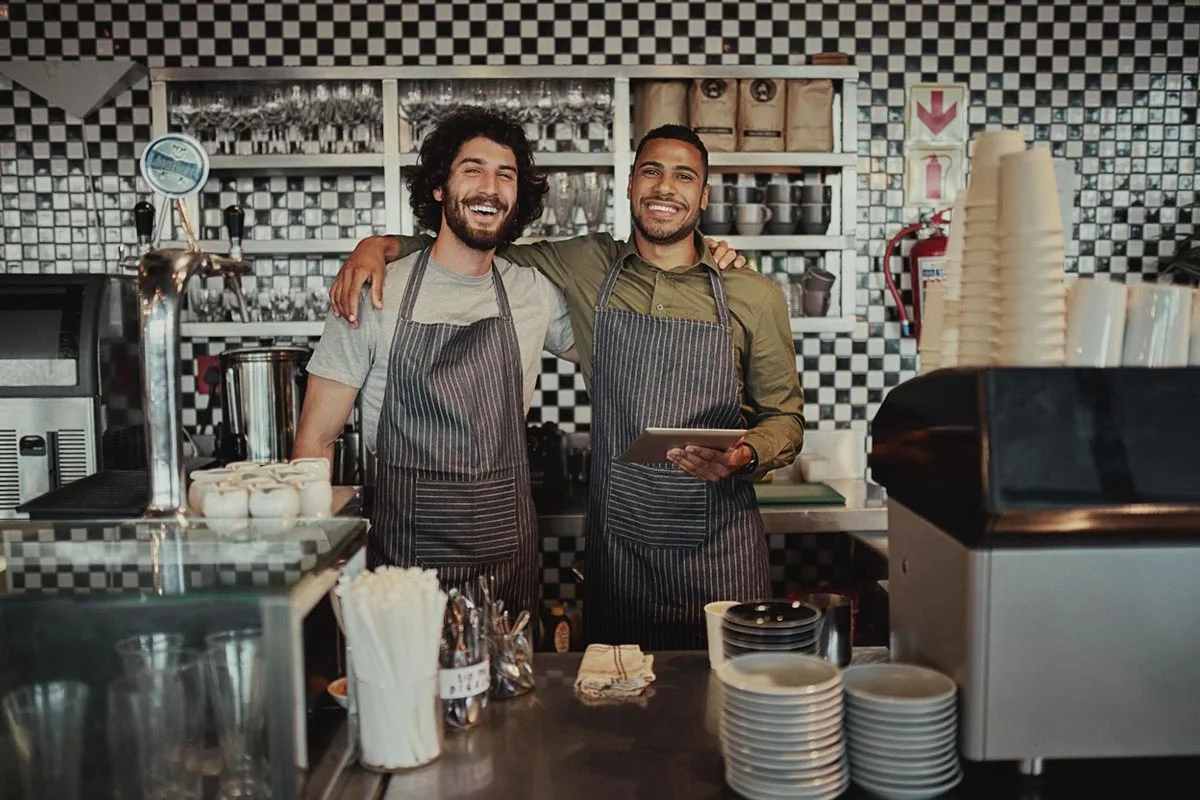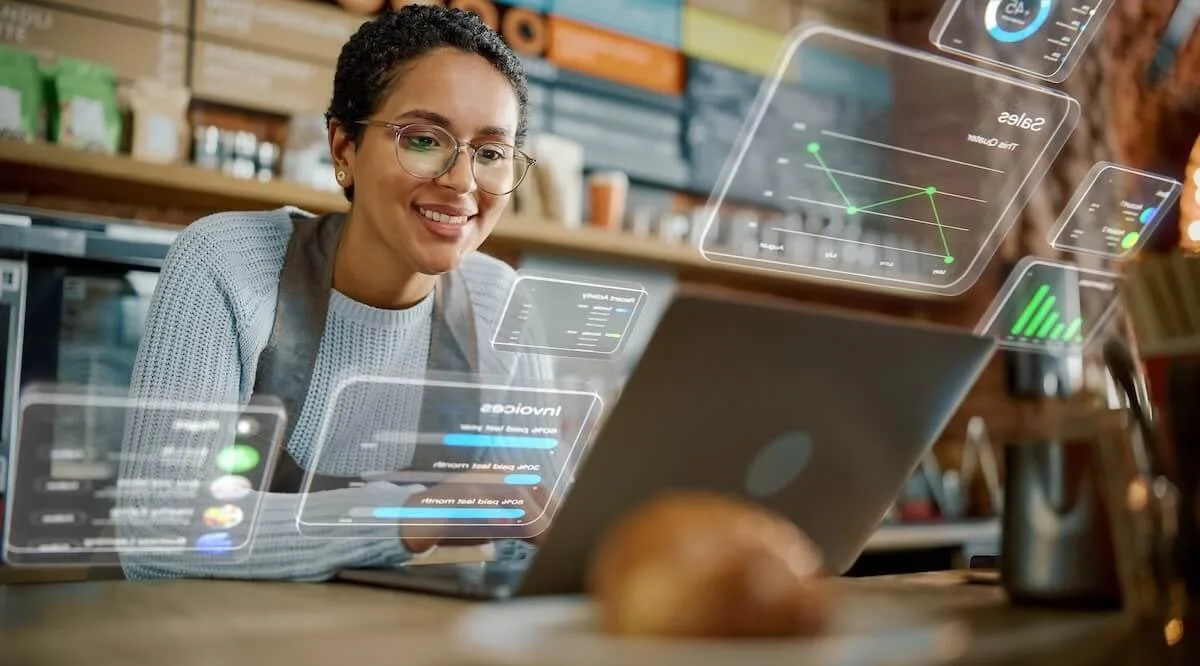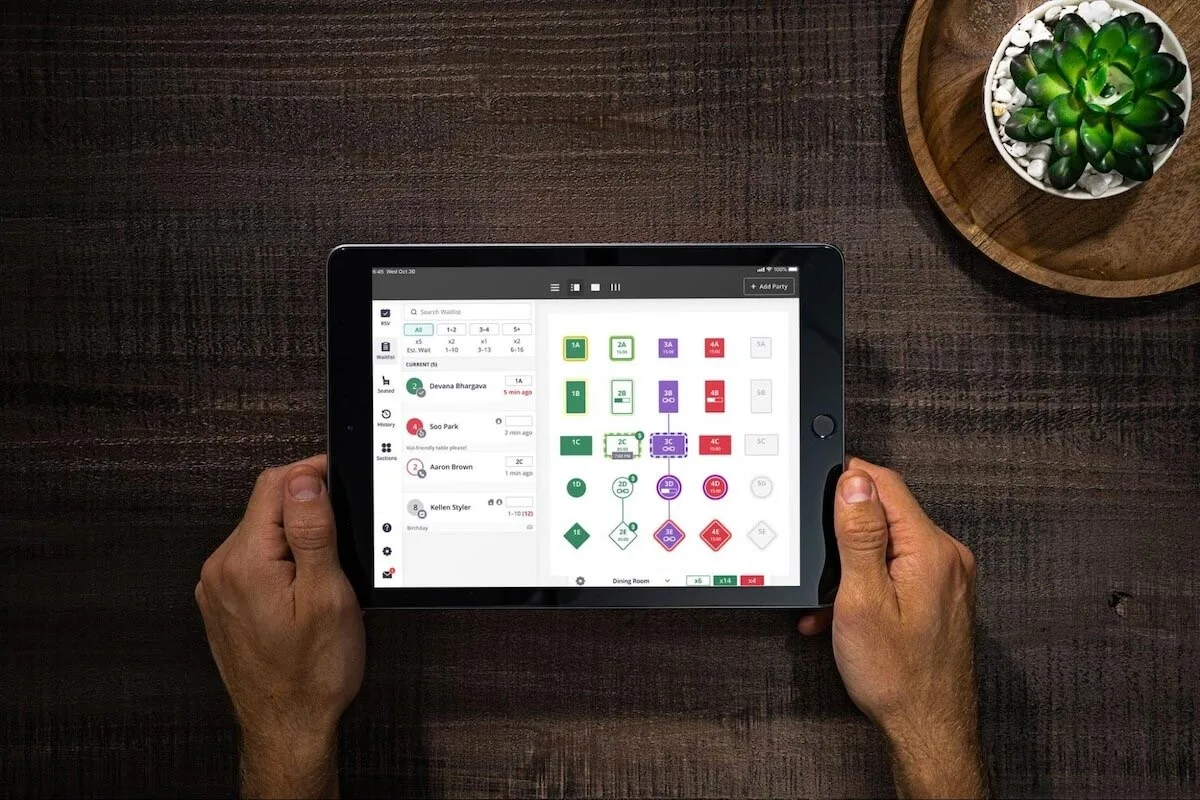Seat more guests and boost profits: Table management guide
Skip the article and turn takeaways into action by scheduling a call with our team.
If you were to take someone from, say, 1980, and show them modern restaurant table management systems, it’d be like taking someone from now and putting them aboard the Starship Enterprise. That is, things have changed a lot, and fast. As front-of-house (FOH) systems approach what appears to be a singularity, the whole staff benefits from automation and improved software functionality.
For customers, this improved restaurant technology means an enhanced dining experience—and ultimately an improved guest experience the whole way through their interaction with the restaurant. For restaurateurs, it means higher revenues, smarter table assignments, customizable floor plans, and, in general, a more valuable dining room.
There are a ton of tools that come with effective table management systems that make life in the restaurant industry easier. Don’t worry—we’ll cover all the ways restaurant operations can be improved here.
For those looking to get up to date with table management, you’re in the right place. First, though: Why does having a good table management system matter so much?

Why table management matters (a lot)
A solid table management strategy means every seat is used efficiently, wait times are minimized, and staff can focus on the human side of the dining experience. Software now provides the critical leg up that restaurants need for clockwork service. Just like a calculator is better at performing quick calculations than even the smartest person, good table management software is way better at running a FOH than a bunch of human brains assembled. So what can restaurants expect from top-tier table management software?
- Revenue maximization: Well-regulated seating means more guests are served, increasing revenue.
- Guest satisfaction: Shorter wait times, accurate table assignments, and personalized dining experiences improve the overall guest experience and encourage repeat visits.
- Efficiency: Streamlined seating processes ward off stress for staff, reduce errors, and make for smoother service at all hours.
- Data insights: Modern table management systems provide all sorts of data to make wise decisions, including table turnover rates, guest preferences, and peak periods.
- A competitive edge: Restaurants that embrace modern table management systems and their benefits, including online reservations and waitlists, estimated wait times, and personalized service, will develop an edge over competitors that remain in the past.
7 ways to get the most out of a restaurant table management system

1. Implement floor planning best practices
A well-designed floor plan is the backbone of effective table management. Maximum seating capacity combined with guest comfort and ease of workflow for staff is the recipe for success. Some strategies to start:
- Conduct a floor plan audit. Map out your restaurant’s floor plan to spot bottlenecks, high-traffic areas, and underused areas.
- Diversify your seating. Offer a mix of 2-tops, 4-tops, group tables, and flexible seating with movable tables for large groups. If possible, expand to offer bar seating, booths, and outdoor seating for extra variety.
- Make the most of your space. Rearrange tables to fit more covers while avoiding overcrowding, leaving enough space for staff and guests to move freely.
- Zone for efficiency. Divide the dining room into zones based on table types or dining experiences, e.g., intimate dining, bar seating, and group areas.
- Consider guest preferences. No one wants to sit next to the bathroom or the service area if they don’t have to, so make those tables last choice or nonexistent.
- Tech up. Use your table management system to customize your floor plan and adapt it as needed.
Yelp Guest Manager helps restaurant owners do all this and much more. Try different layouts during slower periods to find out what works for you. Train staff to adapt to variable floor plans using the software, such as by changing table sizes to reflect group needs.
2. Balance table turnover with guest satisfaction
Table turnover is a key driver of revenue, but it’s a tricky balancing act to maintain. On the one hand, the more customers served, the more a restaurant will make. On the other hand, no one wants to feel rushed when eating, so the customer experience needs to remain comfy. So how to walk this tightrope? Here are some ideas:
- Pace the dining experience. Train staff to guide diners through the meal efficiently, e.g., by suggesting quick-serve menu items during peak hours to reduce table occupancy time.
- Stagger your covers. Tap into Yelp Guest Manager’s pacing software to limit the amount of covers served in a given period, with customizable parameters. This helps prevent both overbooking and underbooking.
- Streamline ordering and payments. Sync table management software with POS systems for fast order processing and tableside payments. Doing so will reduce server trips to the terminal and speed up table turnover.
- Practice smart seating. Use software to assign tables based on party size and reservation patterns. Avoid seating small parties at large tables during peak hours, for example, to allow bigger groups to be seated.
- Follow turnover metrics. Track average table occupancy time and experiment with strategies to reduce that time without damaging the guest experience.
- Train up bussers. Encourage them to remove dirty dishes before a cover is finished without hassling guests, since doing so makes resetting the table easier.
A restaurant that increases its table turnover by 10% can see a commensurate increase in revenue as long as the guest experience remains unchanged.
3. Accommodate guest seating preferences

Understanding your guests’ preferences keeps them happy and loyal—which ideally means coming back regularly. Modern table management systems store guest data, enabling personalized seating and service, and even allowing for pre-booked specific tables. Some steps to start:
- Build guest profiles. Table management software like Yelp Guest Manager helps track preferences like favorite tables, favorite foods or dietary needs, and special occasions like birthdays or anniversaries. If a regular prefers a quiet corner table, assign it automatically when they reserve.
- Offer seating options. As discussed in the first section, providing a variety of choices, such as intimate seating, booths, and bar or outdoor seating, helps cater to different preferences and diner moods.
- Promote preferred seating reservations. Yelp Guest Manager customers can offer specific seating to their guests via Guaranteed Seating Areas when they make reservations—make sure your guests know this!
- Accommodate special requests effortlessly. Train staff to handle requests like accessibility needs or child-friendly seating via notes in your table management system.
- Prioritize high-value guests. Identify loyal regulars and VIPs through their guest profiles and prioritize their seating when possible to further build loyalty and customer retention. A complimentary appetizer or welcome drink offered to a regular can go a long way.
Training staff to regularly check guest profiles upon check-in or when the reservation is first made can ensure guest needs are met before they have to ask. SMS messaging confirmations via Yelp Guest Manager can be set to ask guests about their seating preferences or clarify any special requests.
4. Streamline FOH efficiency

Anyone who’s tried manual table management processes knows they can be time-consuming and cause all sorts of miscommunications. Implementing table management software allows restaurant staff to automate tasks like taking online reservations, assigning tables, and tracking wait times. This both saves time and helps avoid mistakes for everyone involved. Streamline operations and improve efficiency so staff focus on creating a top-notch customer experience instead of pulling their hair out over what’s basically paperwork. Below are three categories to focus on.
Balance reservations and walk-ins
Set reservation system caps to perhaps 60-70% of capacity during peak hours to allow for walk-ins. Doing so ensures you have some flexibility without sacrificing revenue.
Encourage digital reservations via your website, social media Booking Links, and apps like Yelp to reduce (or eliminate) manual booking errors. This is popular—66% of diners say they are more likely to choose a restaurant that takes reservations.*
To manage walk-ins efficiently, use digital waitlists to track your walk-ins and provide accurate wait time estimates. Yelp Guest Manager quotes wait times with up to 92% accuracy.**
Plan your walk-in ratio based on historical data. For example, if Saturdays see more walk-in traffic, set your reservation cap lower than normal.
Improve server efficiency
Sync with POS systems for easy, fast tableside ordering and payments. Orders sent directly to the kitchen reduce the chance of communication errors, and quick credit card payments speed up table turnover.
Automate tasks where possible—for example, lean into tech like Yelp Kiosk as a support for hosts that automatically updates wait times and allows guests to check themselves in. Automated reservations and wait time notifications save FOH staff a lot of time.
Assign servers to specific zones to ensure faster service and better table monitoring. Make sure all staff know which specific tables are theirs.
Train staff to upsell where possible. Use guest data like past orders to recommend high-margin items to increase revenue per cover.
Plan for large parties
Pre-plan for large groups whenever possible, for example, by requiring large parties to book in advance. Collecting credit card holds can be a good way to prevent no-show issues.
Dedicate specific staff like servers or managers to oversee large groups so they receive the necessary attention and good service in general.
If possible, maintain a few modular tables to accommodate unexpected large groups without disrupting the floor plan.
5. Plan for productive communication and data monitoring

Effective table management requires seamless communication and coordination between the entire FOH staff: hosts, servers, managers, bussers, bartenders, and more. So a good table management system will do just that: centralize communications and present them on a platform where all staff can see what’s up and make changes as needed. This lets everyone be on the same page when it comes to seating, serving, and so on.
Good communication and accurate wait times help cut down on no-shows as well, especially since restaurants can communicate directly with customers via SMS with Yelp Guest Manager. Yelp Guest Manager customers have average no-show rates below 10%.***
Here are two key areas to focus on:
Real-time monitoring
- Use table management software to monitor table status (occupied, reserved, or available) in real time, enabling quick adjustments during rushes.
- Tap into systems like Yelp Guest Manager to provide accurate wait time estimates, reducing frustration and improving flow.
- Monitor peak hours to identify bottlenecks and adjust staffing or seating strategies on the fly.
Staff communication
- Make your table management system your single source of truth for seating, reservations, and guest notes—and make sure all staff are on the same page.
- Hold regular pre-shift briefings to know exactly who belongs where doing what, as well as to discuss expected busy hours or anticipated guest needs, e.g., for special requests, groups, events, or VIPs.
- Assign a specific manager or head server to be the head honcho of data and coordination to encourage accountability and clear communication.
6. Make the most of metrics

The analytics that come from table management systems like Yelp Guest Manager can pave the way for informed decision-making. No more poring over papers or shooting from the hip—just real, actionable data.
Best practices for analytics
- Track metrics like table turnover rate, average wait times, revenue per table, and no-show rates. Aim for attainable monthly improvements, e.g., 2-5%.
- Get to know your guests. Use guest profiles to track their purchasing patterns, preferences, and how often they visit.
- Rely on historical data to predict staffing needs. Peak-hour data from previous weeks and months can be a reliable indicator of when you’ll need more staff (and less), which can help reduce wait times during busy periods and reduce labor costs during slow periods.
- Try different pricing strategies. Check your sales data to see what menu items are performing the best and the worst, and consider adjusting prices or offering promotions to reflect their success (or lack thereof).
- Use historical data to forecast demand, getting ahead of inventory issues and stockpiling anticipated necessary items.
- Regularly look at weekly, monthly, and quarterly sales, comparing them to previous periods to identify any overall trends.
7. Train up staff on table management software

Learning any new piece of software can be tricky, even for the most tech-literate among us—especially when the stakes are high. There’s nothing quite like chaos in a restaurant, and anyone who has experienced it wants to avoid it at all costs. So having a single point of contact to help resolve problems with a table management system is a smart idea.
Yelp Guest Manager does just this: We provide an onboarding manager for the duration of the process who’s on call specifically for you and can help put out fires whenever necessary. They can also fix problems before they arise by helping restaurateurs and managers make the smartest decisions for their restaurants.
To ease staff into the transition, try scheduling short training sessions during quieter hours and appointing a tech-savvy team member as the system’s champion.
What about costs?
Restaurateurs would be right to consider costs when upgrading their software. Luckily, a good table management system like Yelp Guest Manager pays for itself quickly via increased revenue and operational efficiency. Best of all, with a flat rate and no cover pricing fee, restaurant owners can easily fit Guest Manager into their budget without having to agonize over which features are worth paying for.
Ready to level up?

So we’ve talked about a table management system’s benefits for all. Yes, we’re a bit biased, but we stand behind Yelp Guest Manager, which does everything listed in this article and then some. It helps customers enjoy their entire journey with your restaurant, from finding you to making a reservation, hopping on a waitlist, or finding an open table via the Yelp app.
If you’re looking to boost your online ordering, Yelp Guest Manager syncs with some of the best third-party delivery services in the business as well.
Want to see if it’s right for you? Or just curious to take a look? Reach out to us for a free demo, and we’ll be happy to get started. The future is now, and getting the best table management system is one of the smartest moves a restaurant owner can make.
**Yelp Internal Data 2024. Based on a study of Yelp Guest Manager restaurants with at least 553 average monthly parties from July 2023 to July 2024. Excludes parties that self-removed before receiving notice that a table was ready. An estimate is accurate if the party is notified +/-5 minutes of the estimated range.
***Yelp Internal Data 2024. Based on a study of Yelp Guest Manager restaurants with at least 553 average monthly parties from July 2023 to July 2024. Excludes parties that self-removed before receiving notice that a table was ready.